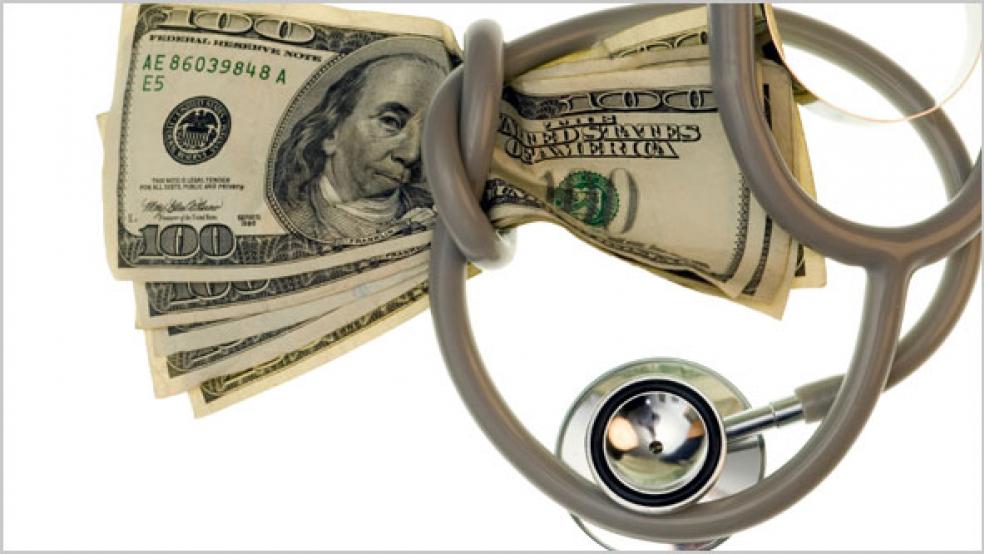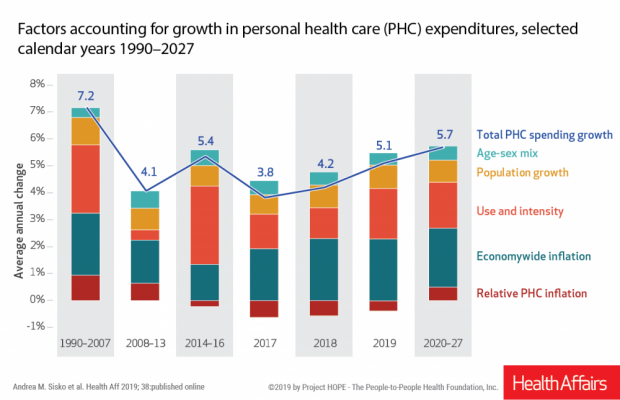As Baby Boomers continue to age and the prices of medical goods and services rise, growth in annual health care spending is projected speed up over the next eight years, the government said Wednesday. Annual health care spending would grow to nearly $6 trillion, or almost 20 percent of the economy, by 2027, according to the projections.
Health care spending is projected to rise by 4.8 percent in 2019, up from 4.4 percent last year — and is expected to grow at an average 5.5 percent a year from 2018 through 2027, actuaries at the Centers for Medicare and Medicaid Services said in a new report published Wednesday in the journal Health Affairs. That level of growth, the same as projected last year, would outpace the forecast for economic expansion by 0.8 percentage points a year.
“As a result of economic and demographic trends, we expect health spending growth to increase over this next decade,” says Andrea Sisko, an economist in the Office of the Actuary at CMS and lead author of the study. “While Medicare spending is expected to accelerate the fastest among payers and contribute to the increase, growth in health prices and disposable personal income are also significant contributors.”
After climbing at an average rate of 7.3 percent a year from 199to 2007, health care spending grew more modestly for a number of years. Economists have debated whether that slowdown was largely the result of the Great Recession and its aftermath, or whether more fundamental structural shifts had taken hold that would lower growth rates longer-term. “The rate of growth is expected to be higher than over the last 10 years but still remain lower” than before the economic downturn, Sisko said.
Health Care as 20 Percent of the Economy: The U.S. spent more than $3.8 trillion on health care in 2018, or nearly 18 percent of gross domestic product. If the CMS projections hold true, health care spending will grow to $5.96 trillion, or 19.4 percent of the economy, by 2027. The share of health care spending financed by federal, state and local governments is expected to reach 47 percent by that year, up from 45 percent last year. “This increase is entirely accounted for by an increase in the federal government share, which largely reflects faster growth in Medicare spending as the baby boom generation continues to transition into the program,” Sisko told reporters.
Prescription Drug Prices Rising Faster, Too: Spending on prescription drugs is expected to accelerate as well. Prescription-drug spending is projected to have grown 3.3 percent last year, up from 0.4 percent in 2017. As an increasing number of new drugs enter the market and prices continue to rise, spending on prescription drugs is expected to rise 4.6 percent this year and by 6.1 percent on average from 2020 through 2027.
Medicare: As Baby Boomers continue to shift from private insurance to Medicare, growth in the government program’s spending will rise faster than for other payers. CMS estimates that 73.5 million people will be enrolled in Medicare by 2027, up from 57.2 million in 2017. It also said it expects annual Medicare enrollment growth to peak at 2.9 percent in 2019.
Medicare spending is projected to have grown by 5.9 percent in 2018, up from 4.2 percent the year before, largely as the result of faster spending growth per enrollee (3.1 percent in 2018 versus 1.7 percent in 2017). And spending growth for the program is projected to accelerate further, reaching 7.1 percent this year and averaging 7.6 percent from 2020 through 2027.
Medicaid: Spending growth for the health care program for low-income Americans is projected to have been 2.2 percent last year, down 0.7 percentage points, as the result of a fourth straight year of slower enrollment growth. But spending is expected to rise 4.8 percent this year, in part because of new Medicaid expansion under the Affordable Care Act in Idaho, Maine, Nebraska, Utah and Virginia. Medicaid spending is expected to grow at an average annual rate of 6 percent from 2020 through 2027.
Private insurers: Spending is projected to have grown by 4.5 percent last year and is expected to slot to 3.3 percent this year as some people choose to drop coverage now that the Affordable Care Act’s individual mandate has been repealed. (Out-of-pocket spending, on the other hand, is expected to grow more quickly once fewer people have private coverage.) Private health insurance spending is expected to grow an average 5.1 percent a year from 2020 through 2027.
Other key projections:
- Prices for health care goods and services are projected to rise by an average 2.5 percent a year, accounting for almost half of the expected increase in personal health care outlays.
- Hospital spending is projected to have grown by 4.4 percent in 2018 and is expected to rise by 5.1 percent this year and an average of 5.7 percent a year from 2020 through 2027.
- The share of the population that has insurance is expected to remain stable around 90 percent over the next eight years.
Keep in mind, though, that these are projections — and they’re not easy to make let alone nail. For one thing, they’re based on current law and do not try to predict how the health care system might change over the coming years. For example, CMS forecast last year that health care spending would grow by 5.3 percent in 2018, nearly a percentage point higher than it now projects they grew.







